Management and Organization Report: Planning and Strategic Analysis
VerifiedAdded on 2022/11/25
|13
|2770
|118
Report
AI Summary
This report provides an executive summary and critical analysis of management and organization, focusing on the importance of planning in achieving business success. It explores the roles of the board of directors and executive management in strategic planning, highlighting opportunities such as financial benefits, competitive advantage, and optimum resource utilization, while also addressing constraints like rigidity, dynamic environment challenges, and time consumption. The report discusses the impact of these factors on future decisions, emphasizing the need for innovative ideas, diversification, and risk mitigation. It covers various aspects of planning, including financial benefits, organizational activities, and the use of resources. The report also delves into the constraints such as rigidity, dynamic environments, and time consumption, affecting the planning process. The report concludes by discussing the challenges and opportunities encountered by the board of members and executive management during future strategic planning.
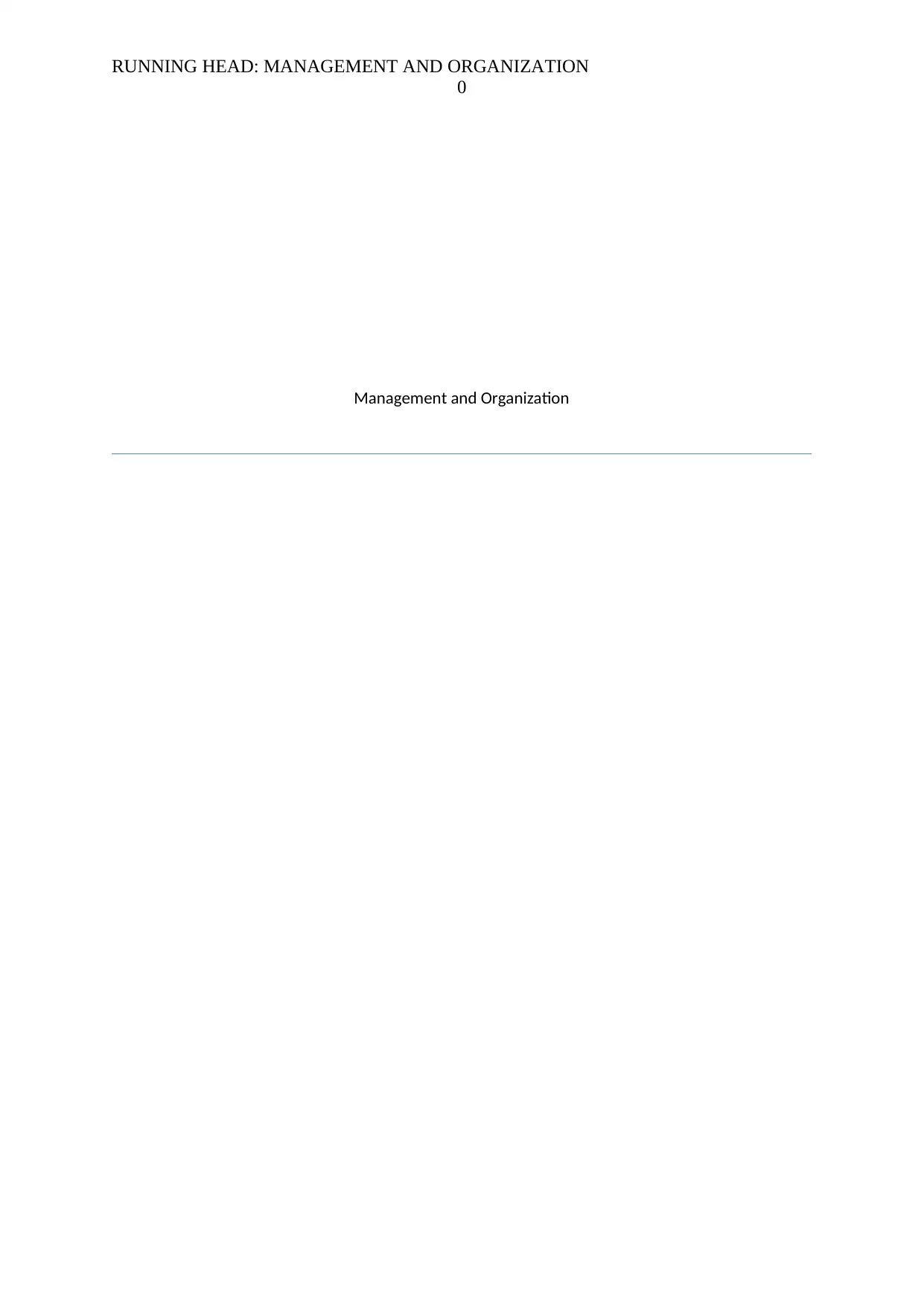
RUNNING HEAD: MANAGEMENT AND ORGANIZATION
0
Management and Organization
0
Management and Organization
Paraphrase This Document
Need a fresh take? Get an instant paraphrase of this document with our AI Paraphraser
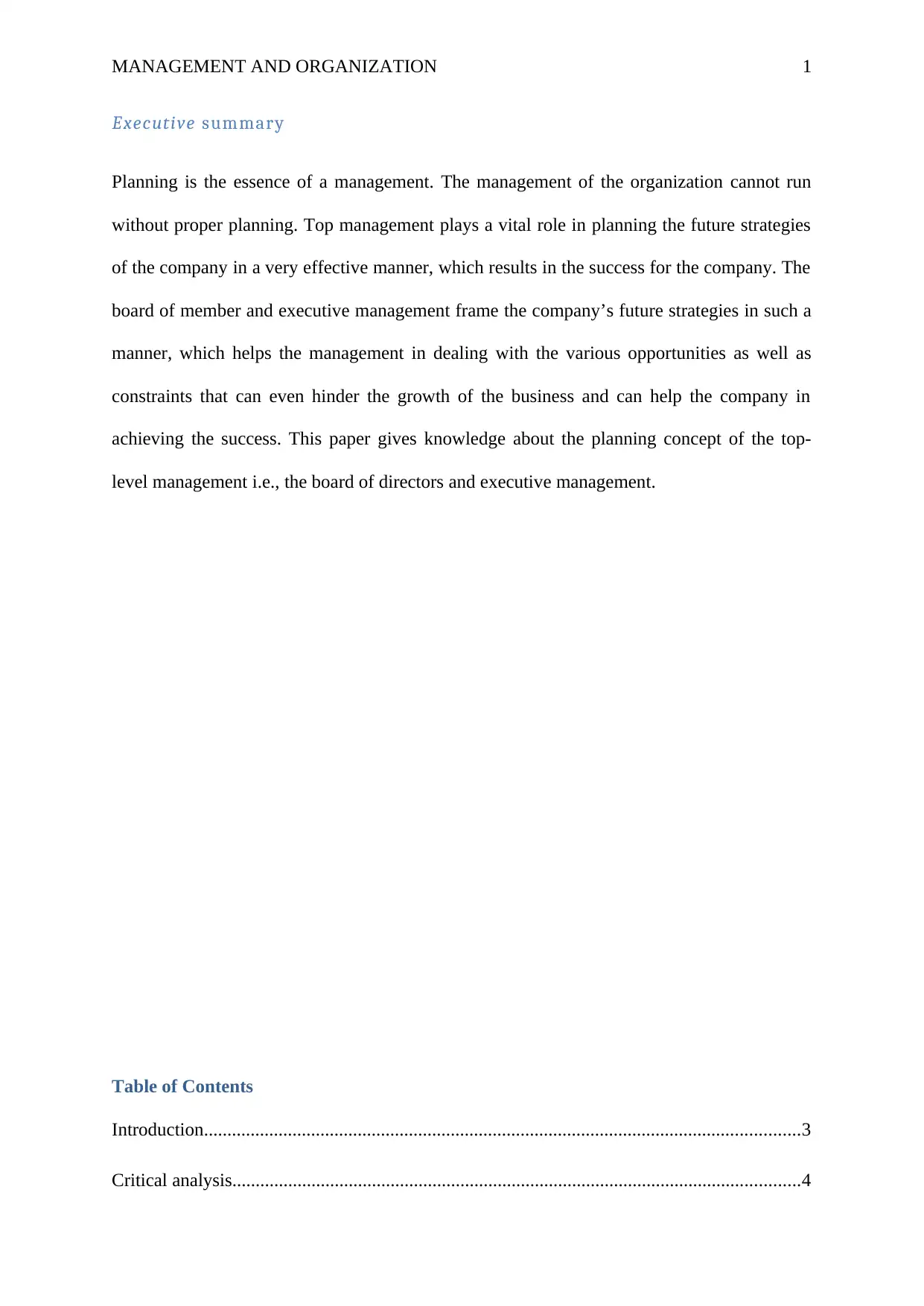
MANAGEMENT AND ORGANIZATION 1
Executive summary
Planning is the essence of a management. The management of the organization cannot run
without proper planning. Top management plays a vital role in planning the future strategies
of the company in a very effective manner, which results in the success for the company. The
board of member and executive management frame the company’s future strategies in such a
manner, which helps the management in dealing with the various opportunities as well as
constraints that can even hinder the growth of the business and can help the company in
achieving the success. This paper gives knowledge about the planning concept of the top-
level management i.e., the board of directors and executive management.
Table of Contents
Introduction................................................................................................................................3
Critical analysis..........................................................................................................................4
Executive summary
Planning is the essence of a management. The management of the organization cannot run
without proper planning. Top management plays a vital role in planning the future strategies
of the company in a very effective manner, which results in the success for the company. The
board of member and executive management frame the company’s future strategies in such a
manner, which helps the management in dealing with the various opportunities as well as
constraints that can even hinder the growth of the business and can help the company in
achieving the success. This paper gives knowledge about the planning concept of the top-
level management i.e., the board of directors and executive management.
Table of Contents
Introduction................................................................................................................................3
Critical analysis..........................................................................................................................4
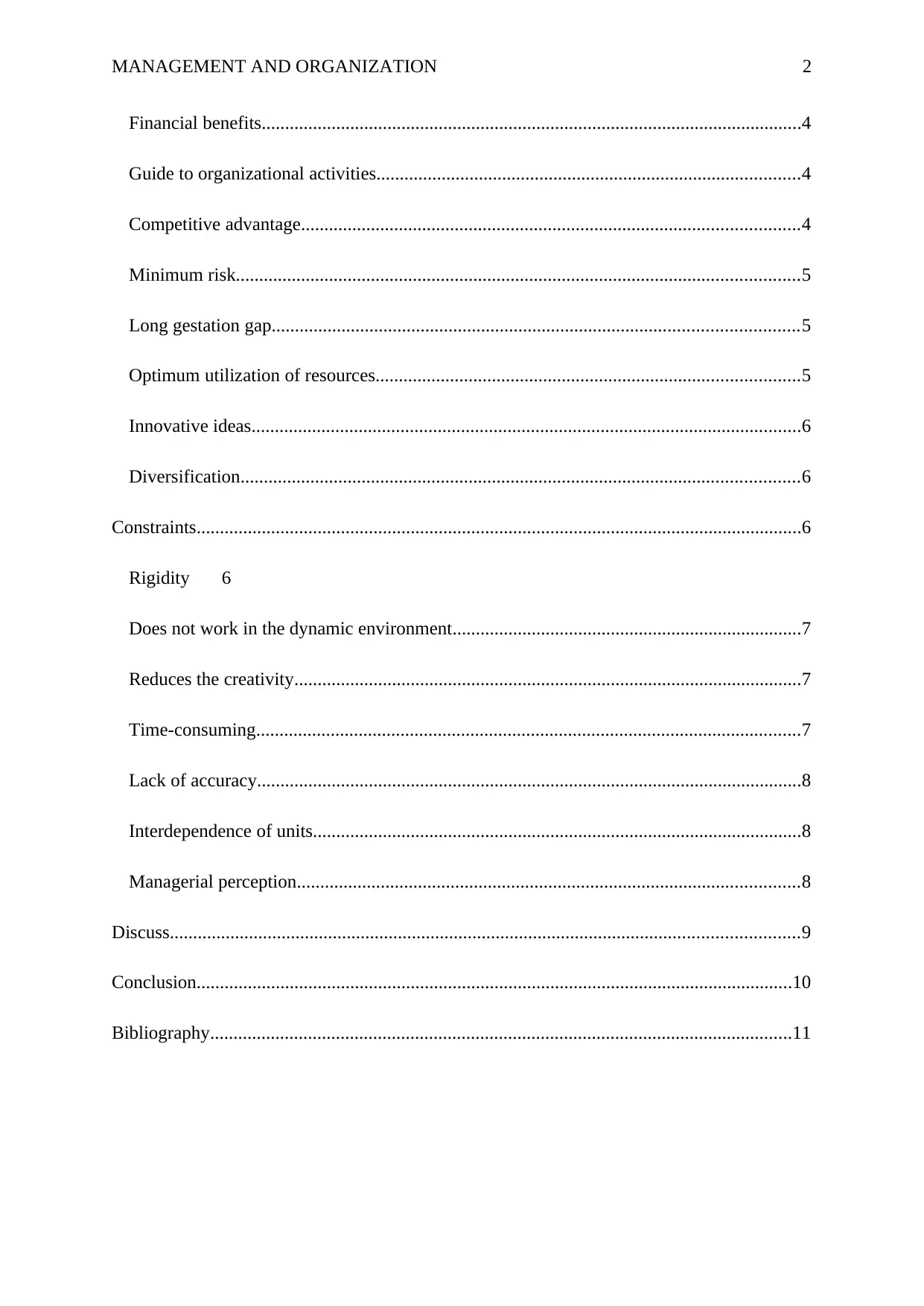
MANAGEMENT AND ORGANIZATION 2
Financial benefits....................................................................................................................4
Guide to organizational activities...........................................................................................4
Competitive advantage...........................................................................................................4
Minimum risk.........................................................................................................................5
Long gestation gap.................................................................................................................5
Optimum utilization of resources...........................................................................................5
Innovative ideas......................................................................................................................6
Diversification........................................................................................................................6
Constraints..................................................................................................................................6
Rigidity 6
Does not work in the dynamic environment...........................................................................7
Reduces the creativity.............................................................................................................7
Time-consuming.....................................................................................................................7
Lack of accuracy.....................................................................................................................8
Interdependence of units.........................................................................................................8
Managerial perception............................................................................................................8
Discuss.......................................................................................................................................9
Conclusion................................................................................................................................10
Bibliography.............................................................................................................................11
Financial benefits....................................................................................................................4
Guide to organizational activities...........................................................................................4
Competitive advantage...........................................................................................................4
Minimum risk.........................................................................................................................5
Long gestation gap.................................................................................................................5
Optimum utilization of resources...........................................................................................5
Innovative ideas......................................................................................................................6
Diversification........................................................................................................................6
Constraints..................................................................................................................................6
Rigidity 6
Does not work in the dynamic environment...........................................................................7
Reduces the creativity.............................................................................................................7
Time-consuming.....................................................................................................................7
Lack of accuracy.....................................................................................................................8
Interdependence of units.........................................................................................................8
Managerial perception............................................................................................................8
Discuss.......................................................................................................................................9
Conclusion................................................................................................................................10
Bibliography.............................................................................................................................11
⊘ This is a preview!⊘
Do you want full access?
Subscribe today to unlock all pages.

Trusted by 1+ million students worldwide
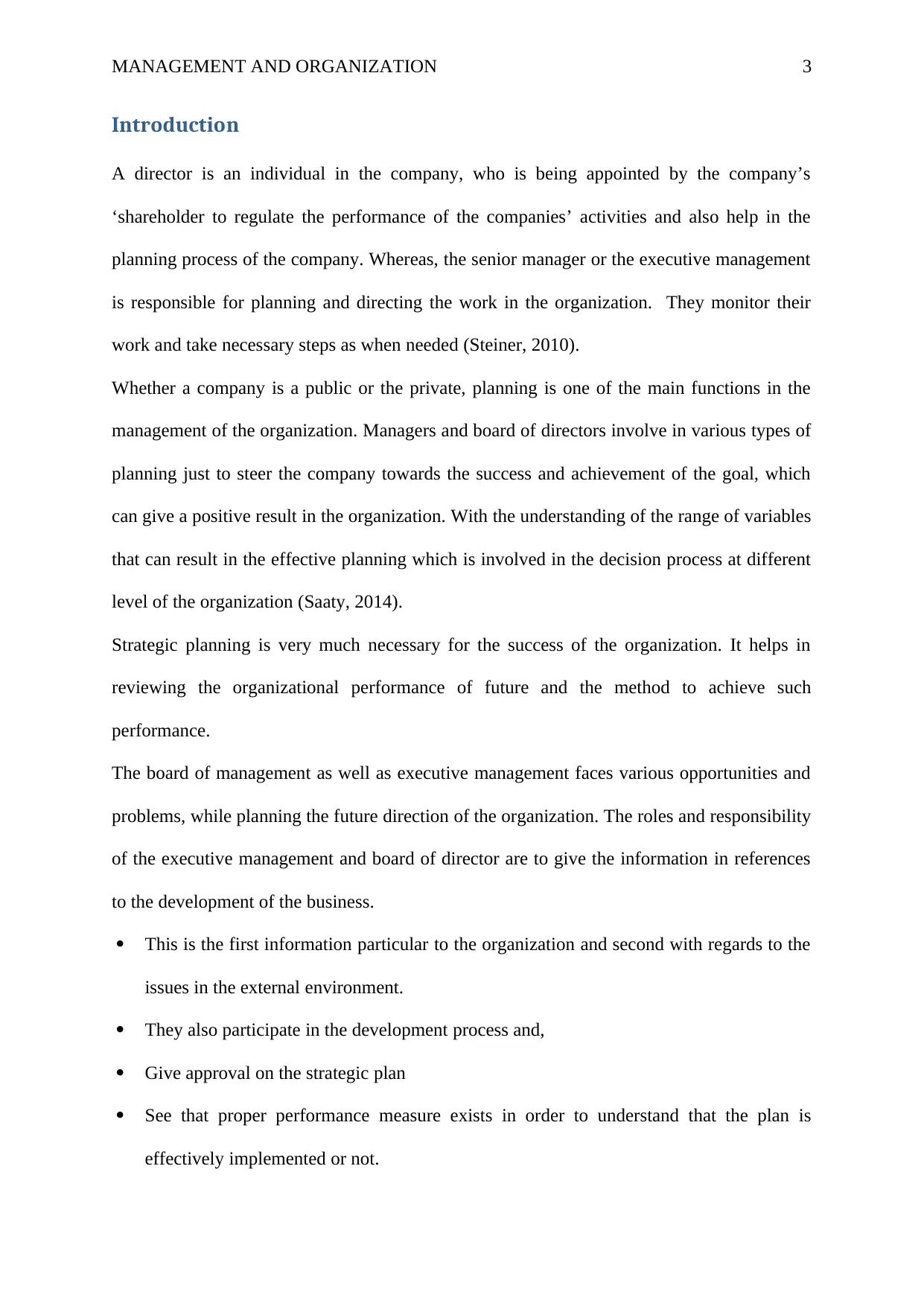
MANAGEMENT AND ORGANIZATION 3
Introduction
A director is an individual in the company, who is being appointed by the company’s
‘shareholder to regulate the performance of the companies’ activities and also help in the
planning process of the company. Whereas, the senior manager or the executive management
is responsible for planning and directing the work in the organization. They monitor their
work and take necessary steps as when needed (Steiner, 2010).
Whether a company is a public or the private, planning is one of the main functions in the
management of the organization. Managers and board of directors involve in various types of
planning just to steer the company towards the success and achievement of the goal, which
can give a positive result in the organization. With the understanding of the range of variables
that can result in the effective planning which is involved in the decision process at different
level of the organization (Saaty, 2014).
Strategic planning is very much necessary for the success of the organization. It helps in
reviewing the organizational performance of future and the method to achieve such
performance.
The board of management as well as executive management faces various opportunities and
problems, while planning the future direction of the organization. The roles and responsibility
of the executive management and board of director are to give the information in references
to the development of the business.
This is the first information particular to the organization and second with regards to the
issues in the external environment.
They also participate in the development process and,
Give approval on the strategic plan
See that proper performance measure exists in order to understand that the plan is
effectively implemented or not.
Introduction
A director is an individual in the company, who is being appointed by the company’s
‘shareholder to regulate the performance of the companies’ activities and also help in the
planning process of the company. Whereas, the senior manager or the executive management
is responsible for planning and directing the work in the organization. They monitor their
work and take necessary steps as when needed (Steiner, 2010).
Whether a company is a public or the private, planning is one of the main functions in the
management of the organization. Managers and board of directors involve in various types of
planning just to steer the company towards the success and achievement of the goal, which
can give a positive result in the organization. With the understanding of the range of variables
that can result in the effective planning which is involved in the decision process at different
level of the organization (Saaty, 2014).
Strategic planning is very much necessary for the success of the organization. It helps in
reviewing the organizational performance of future and the method to achieve such
performance.
The board of management as well as executive management faces various opportunities and
problems, while planning the future direction of the organization. The roles and responsibility
of the executive management and board of director are to give the information in references
to the development of the business.
This is the first information particular to the organization and second with regards to the
issues in the external environment.
They also participate in the development process and,
Give approval on the strategic plan
See that proper performance measure exists in order to understand that the plan is
effectively implemented or not.
Paraphrase This Document
Need a fresh take? Get an instant paraphrase of this document with our AI Paraphraser
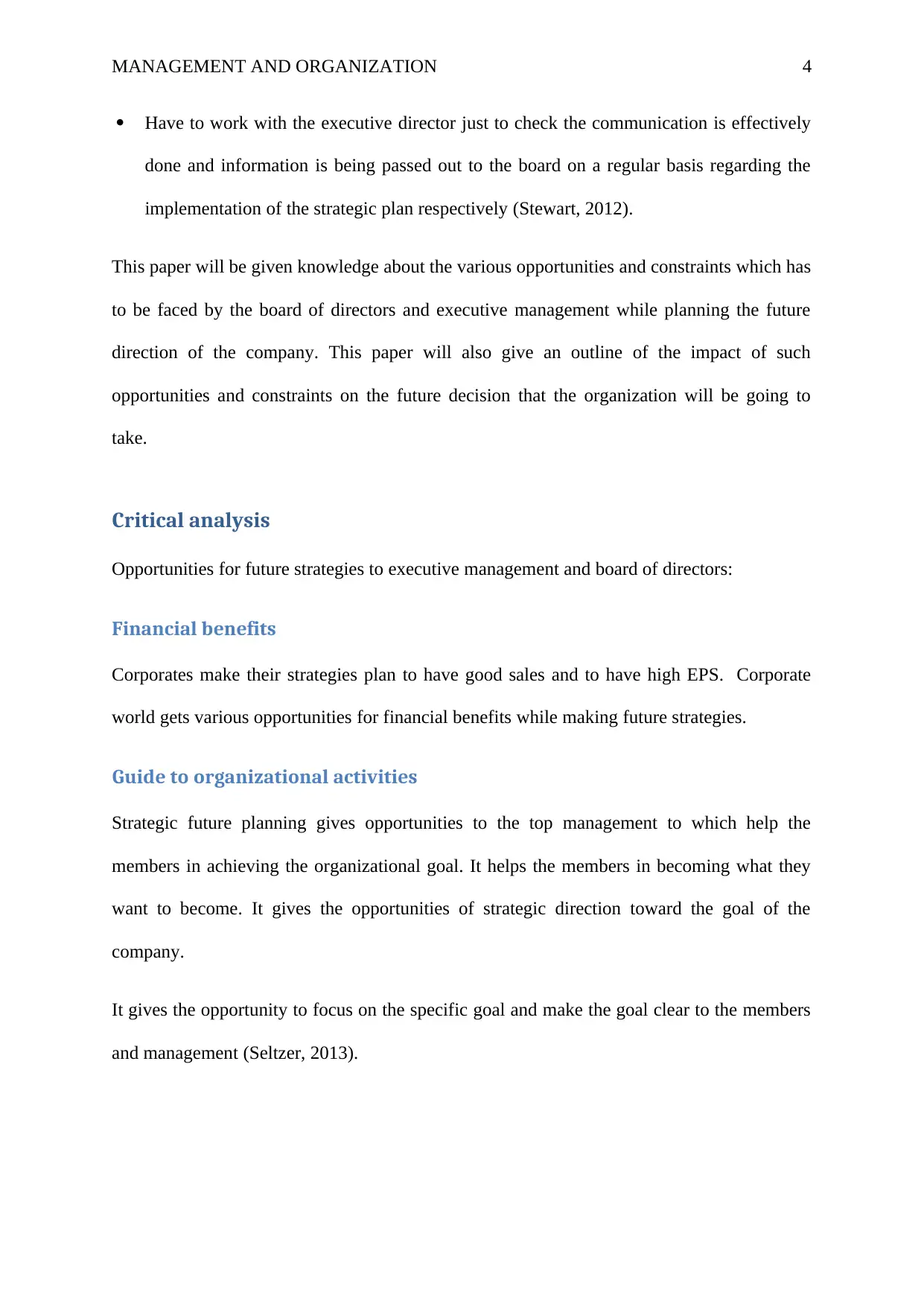
MANAGEMENT AND ORGANIZATION 4
Have to work with the executive director just to check the communication is effectively
done and information is being passed out to the board on a regular basis regarding the
implementation of the strategic plan respectively (Stewart, 2012).
This paper will be given knowledge about the various opportunities and constraints which has
to be faced by the board of directors and executive management while planning the future
direction of the company. This paper will also give an outline of the impact of such
opportunities and constraints on the future decision that the organization will be going to
take.
Critical analysis
Opportunities for future strategies to executive management and board of directors:
Financial benefits
Corporates make their strategies plan to have good sales and to have high EPS. Corporate
world gets various opportunities for financial benefits while making future strategies.
Guide to organizational activities
Strategic future planning gives opportunities to the top management to which help the
members in achieving the organizational goal. It helps the members in becoming what they
want to become. It gives the opportunities of strategic direction toward the goal of the
company.
It gives the opportunity to focus on the specific goal and make the goal clear to the members
and management (Seltzer, 2013).
Have to work with the executive director just to check the communication is effectively
done and information is being passed out to the board on a regular basis regarding the
implementation of the strategic plan respectively (Stewart, 2012).
This paper will be given knowledge about the various opportunities and constraints which has
to be faced by the board of directors and executive management while planning the future
direction of the company. This paper will also give an outline of the impact of such
opportunities and constraints on the future decision that the organization will be going to
take.
Critical analysis
Opportunities for future strategies to executive management and board of directors:
Financial benefits
Corporates make their strategies plan to have good sales and to have high EPS. Corporate
world gets various opportunities for financial benefits while making future strategies.
Guide to organizational activities
Strategic future planning gives opportunities to the top management to which help the
members in achieving the organizational goal. It helps the members in becoming what they
want to become. It gives the opportunities of strategic direction toward the goal of the
company.
It gives the opportunity to focus on the specific goal and make the goal clear to the members
and management (Seltzer, 2013).
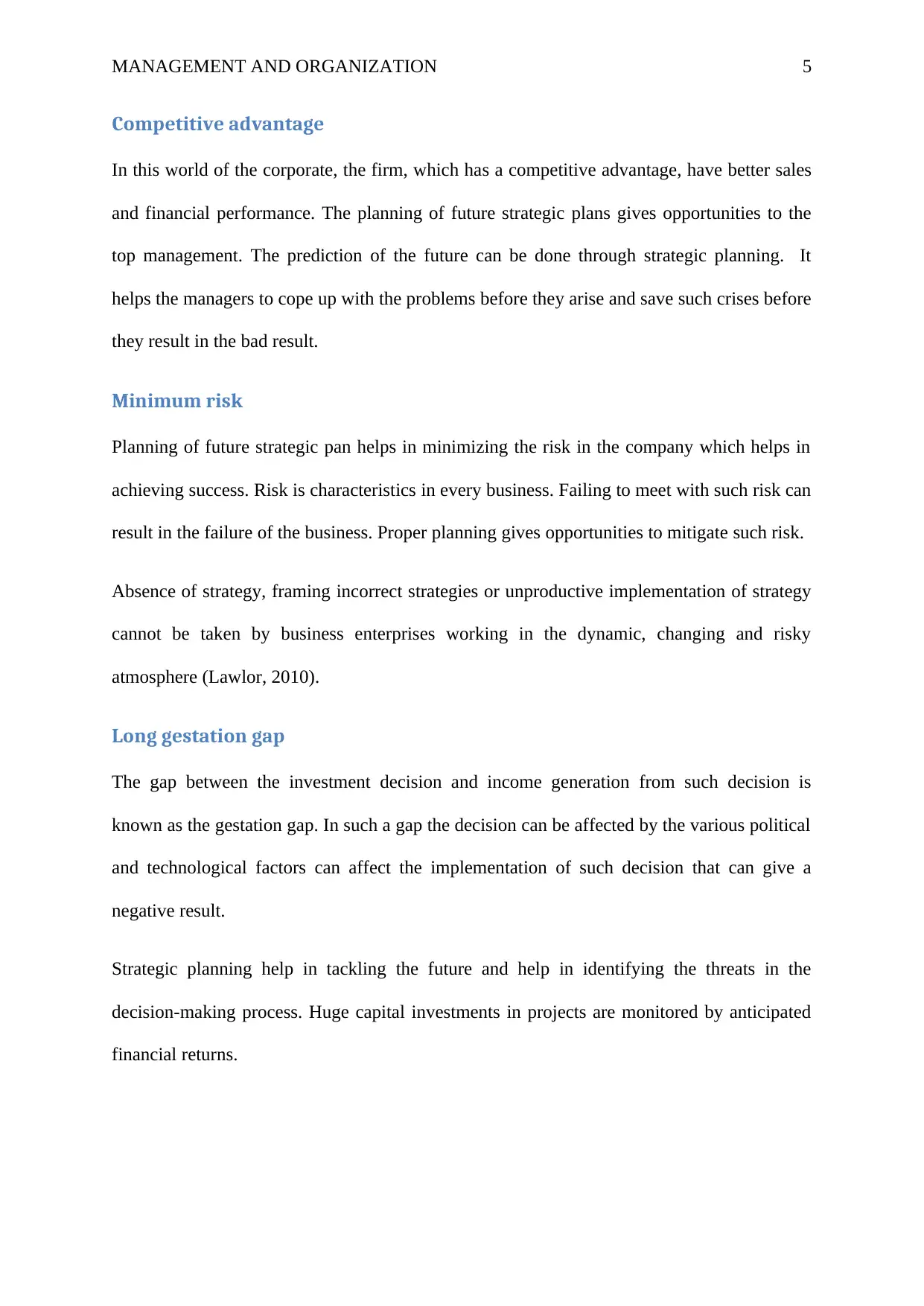
MANAGEMENT AND ORGANIZATION 5
Competitive advantage
In this world of the corporate, the firm, which has a competitive advantage, have better sales
and financial performance. The planning of future strategic plans gives opportunities to the
top management. The prediction of the future can be done through strategic planning. It
helps the managers to cope up with the problems before they arise and save such crises before
they result in the bad result.
Minimum risk
Planning of future strategic pan helps in minimizing the risk in the company which helps in
achieving success. Risk is characteristics in every business. Failing to meet with such risk can
result in the failure of the business. Proper planning gives opportunities to mitigate such risk.
Absence of strategy, framing incorrect strategies or unproductive implementation of strategy
cannot be taken by business enterprises working in the dynamic, changing and risky
atmosphere (Lawlor, 2010).
Long gestation gap
The gap between the investment decision and income generation from such decision is
known as the gestation gap. In such a gap the decision can be affected by the various political
and technological factors can affect the implementation of such decision that can give a
negative result.
Strategic planning help in tackling the future and help in identifying the threats in the
decision-making process. Huge capital investments in projects are monitored by anticipated
financial returns.
Competitive advantage
In this world of the corporate, the firm, which has a competitive advantage, have better sales
and financial performance. The planning of future strategic plans gives opportunities to the
top management. The prediction of the future can be done through strategic planning. It
helps the managers to cope up with the problems before they arise and save such crises before
they result in the bad result.
Minimum risk
Planning of future strategic pan helps in minimizing the risk in the company which helps in
achieving success. Risk is characteristics in every business. Failing to meet with such risk can
result in the failure of the business. Proper planning gives opportunities to mitigate such risk.
Absence of strategy, framing incorrect strategies or unproductive implementation of strategy
cannot be taken by business enterprises working in the dynamic, changing and risky
atmosphere (Lawlor, 2010).
Long gestation gap
The gap between the investment decision and income generation from such decision is
known as the gestation gap. In such a gap the decision can be affected by the various political
and technological factors can affect the implementation of such decision that can give a
negative result.
Strategic planning help in tackling the future and help in identifying the threats in the
decision-making process. Huge capital investments in projects are monitored by anticipated
financial returns.
⊘ This is a preview!⊘
Do you want full access?
Subscribe today to unlock all pages.

Trusted by 1+ million students worldwide
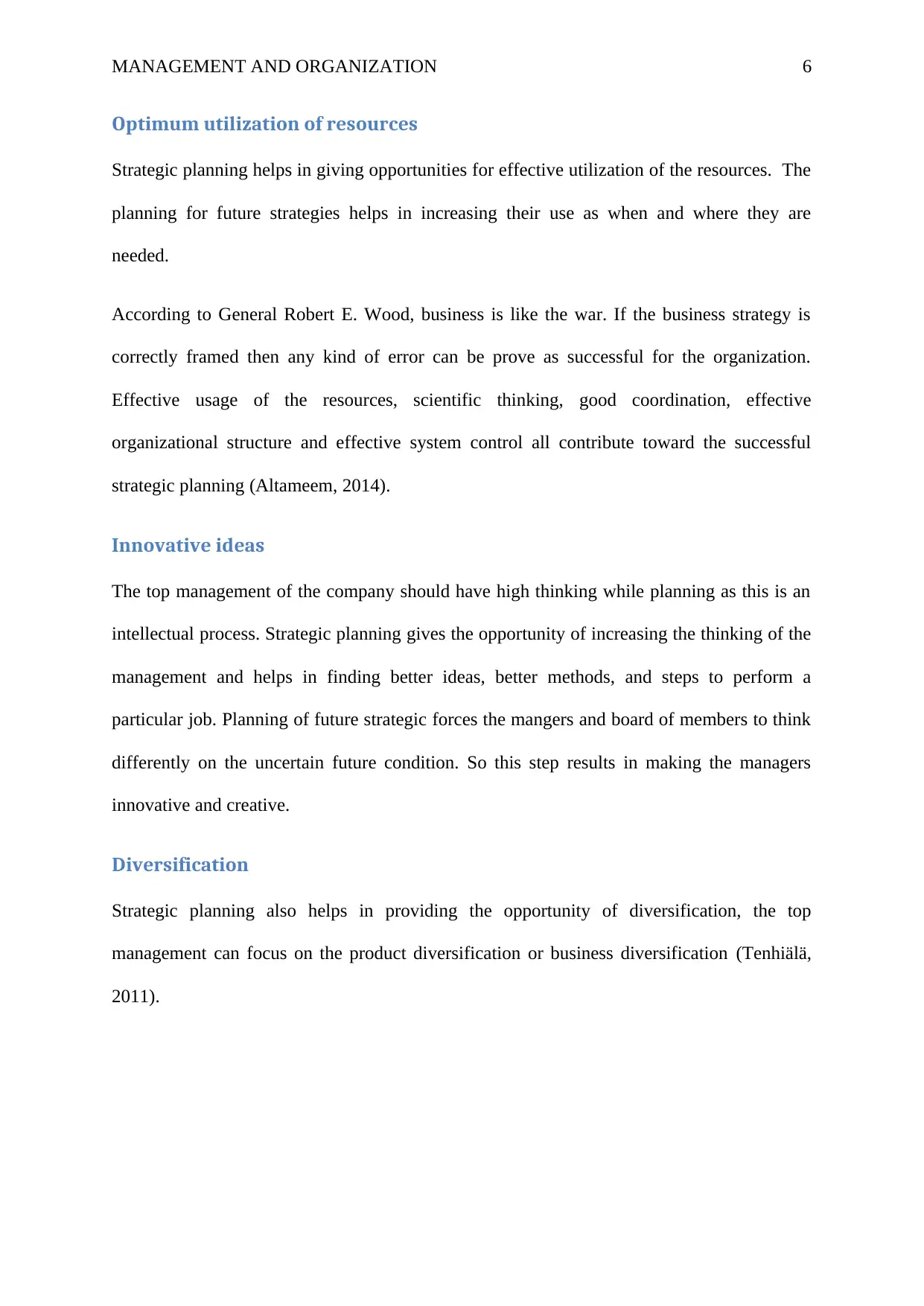
MANAGEMENT AND ORGANIZATION 6
Optimum utilization of resources
Strategic planning helps in giving opportunities for effective utilization of the resources. The
planning for future strategies helps in increasing their use as when and where they are
needed.
According to General Robert E. Wood, business is like the war. If the business strategy is
correctly framed then any kind of error can be prove as successful for the organization.
Effective usage of the resources, scientific thinking, good coordination, effective
organizational structure and effective system control all contribute toward the successful
strategic planning (Altameem, 2014).
Innovative ideas
The top management of the company should have high thinking while planning as this is an
intellectual process. Strategic planning gives the opportunity of increasing the thinking of the
management and helps in finding better ideas, better methods, and steps to perform a
particular job. Planning of future strategic forces the mangers and board of members to think
differently on the uncertain future condition. So this step results in making the managers
innovative and creative.
Diversification
Strategic planning also helps in providing the opportunity of diversification, the top
management can focus on the product diversification or business diversification (Tenhiälä,
2011).
Optimum utilization of resources
Strategic planning helps in giving opportunities for effective utilization of the resources. The
planning for future strategies helps in increasing their use as when and where they are
needed.
According to General Robert E. Wood, business is like the war. If the business strategy is
correctly framed then any kind of error can be prove as successful for the organization.
Effective usage of the resources, scientific thinking, good coordination, effective
organizational structure and effective system control all contribute toward the successful
strategic planning (Altameem, 2014).
Innovative ideas
The top management of the company should have high thinking while planning as this is an
intellectual process. Strategic planning gives the opportunity of increasing the thinking of the
management and helps in finding better ideas, better methods, and steps to perform a
particular job. Planning of future strategic forces the mangers and board of members to think
differently on the uncertain future condition. So this step results in making the managers
innovative and creative.
Diversification
Strategic planning also helps in providing the opportunity of diversification, the top
management can focus on the product diversification or business diversification (Tenhiälä,
2011).
Paraphrase This Document
Need a fresh take? Get an instant paraphrase of this document with our AI Paraphraser
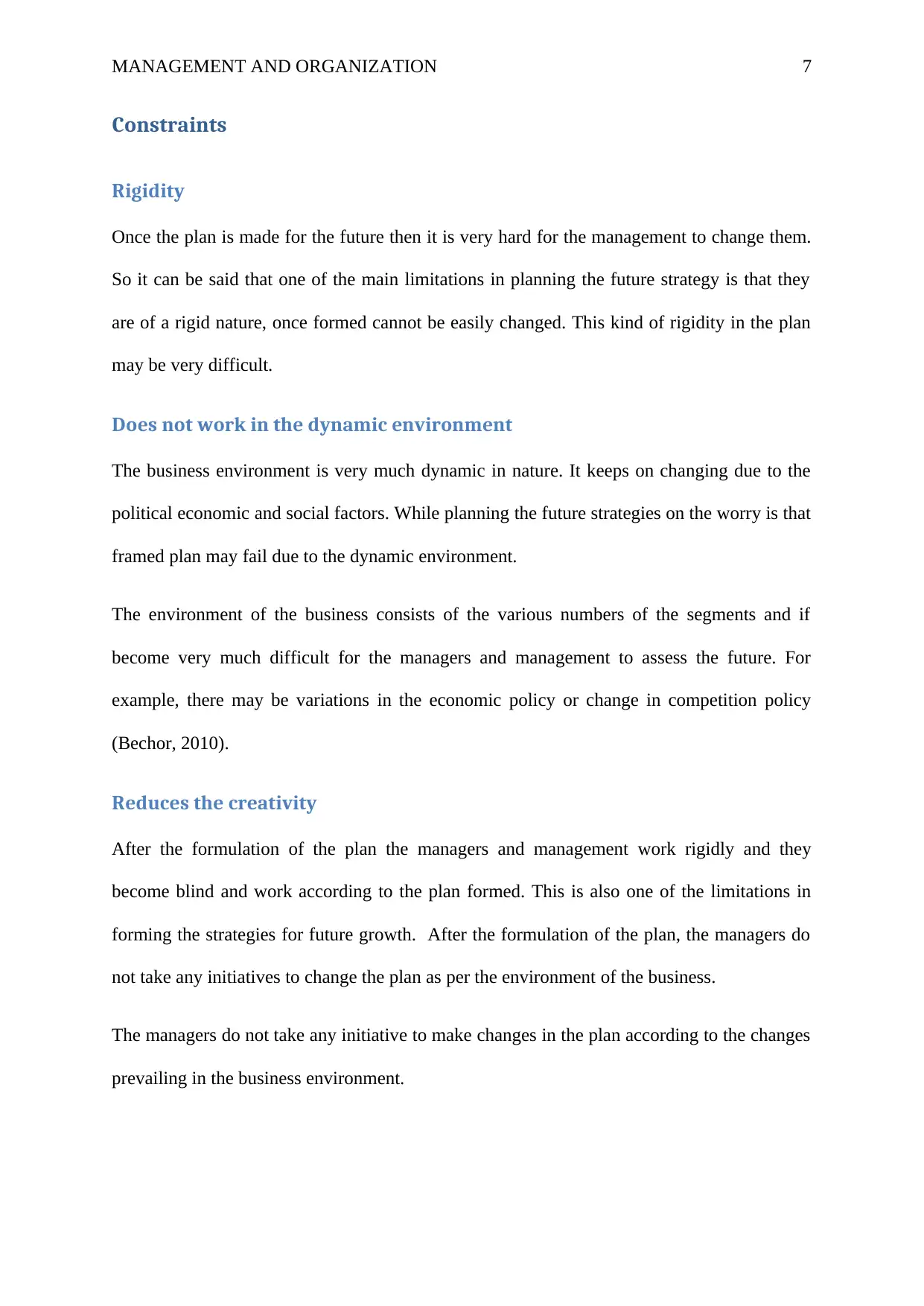
MANAGEMENT AND ORGANIZATION 7
Constraints
Rigidity
Once the plan is made for the future then it is very hard for the management to change them.
So it can be said that one of the main limitations in planning the future strategy is that they
are of a rigid nature, once formed cannot be easily changed. This kind of rigidity in the plan
may be very difficult.
Does not work in the dynamic environment
The business environment is very much dynamic in nature. It keeps on changing due to the
political economic and social factors. While planning the future strategies on the worry is that
framed plan may fail due to the dynamic environment.
The environment of the business consists of the various numbers of the segments and if
become very much difficult for the managers and management to assess the future. For
example, there may be variations in the economic policy or change in competition policy
(Bechor, 2010).
Reduces the creativity
After the formulation of the plan the managers and management work rigidly and they
become blind and work according to the plan formed. This is also one of the limitations in
forming the strategies for future growth. After the formulation of the plan, the managers do
not take any initiatives to change the plan as per the environment of the business.
The managers do not take any initiative to make changes in the plan according to the changes
prevailing in the business environment.
Constraints
Rigidity
Once the plan is made for the future then it is very hard for the management to change them.
So it can be said that one of the main limitations in planning the future strategy is that they
are of a rigid nature, once formed cannot be easily changed. This kind of rigidity in the plan
may be very difficult.
Does not work in the dynamic environment
The business environment is very much dynamic in nature. It keeps on changing due to the
political economic and social factors. While planning the future strategies on the worry is that
framed plan may fail due to the dynamic environment.
The environment of the business consists of the various numbers of the segments and if
become very much difficult for the managers and management to assess the future. For
example, there may be variations in the economic policy or change in competition policy
(Bechor, 2010).
Reduces the creativity
After the formulation of the plan the managers and management work rigidly and they
become blind and work according to the plan formed. This is also one of the limitations in
forming the strategies for future growth. After the formulation of the plan, the managers do
not take any initiatives to change the plan as per the environment of the business.
The managers do not take any initiative to make changes in the plan according to the changes
prevailing in the business environment.
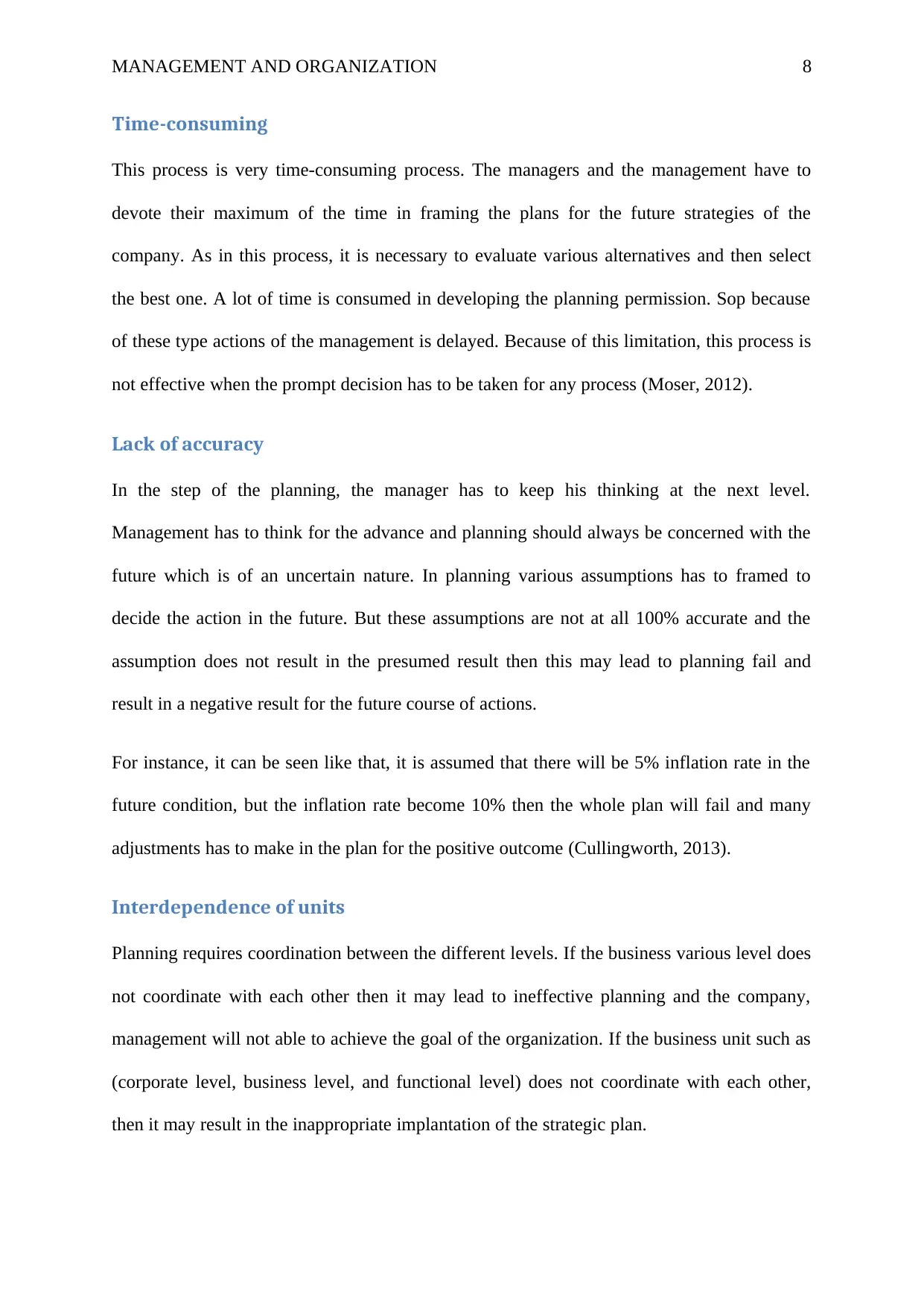
MANAGEMENT AND ORGANIZATION 8
Time-consuming
This process is very time-consuming process. The managers and the management have to
devote their maximum of the time in framing the plans for the future strategies of the
company. As in this process, it is necessary to evaluate various alternatives and then select
the best one. A lot of time is consumed in developing the planning permission. Sop because
of these type actions of the management is delayed. Because of this limitation, this process is
not effective when the prompt decision has to be taken for any process (Moser, 2012).
Lack of accuracy
In the step of the planning, the manager has to keep his thinking at the next level.
Management has to think for the advance and planning should always be concerned with the
future which is of an uncertain nature. In planning various assumptions has to framed to
decide the action in the future. But these assumptions are not at all 100% accurate and the
assumption does not result in the presumed result then this may lead to planning fail and
result in a negative result for the future course of actions.
For instance, it can be seen like that, it is assumed that there will be 5% inflation rate in the
future condition, but the inflation rate become 10% then the whole plan will fail and many
adjustments has to make in the plan for the positive outcome (Cullingworth, 2013).
Interdependence of units
Planning requires coordination between the different levels. If the business various level does
not coordinate with each other then it may lead to ineffective planning and the company,
management will not able to achieve the goal of the organization. If the business unit such as
(corporate level, business level, and functional level) does not coordinate with each other,
then it may result in the inappropriate implantation of the strategic plan.
Time-consuming
This process is very time-consuming process. The managers and the management have to
devote their maximum of the time in framing the plans for the future strategies of the
company. As in this process, it is necessary to evaluate various alternatives and then select
the best one. A lot of time is consumed in developing the planning permission. Sop because
of these type actions of the management is delayed. Because of this limitation, this process is
not effective when the prompt decision has to be taken for any process (Moser, 2012).
Lack of accuracy
In the step of the planning, the manager has to keep his thinking at the next level.
Management has to think for the advance and planning should always be concerned with the
future which is of an uncertain nature. In planning various assumptions has to framed to
decide the action in the future. But these assumptions are not at all 100% accurate and the
assumption does not result in the presumed result then this may lead to planning fail and
result in a negative result for the future course of actions.
For instance, it can be seen like that, it is assumed that there will be 5% inflation rate in the
future condition, but the inflation rate become 10% then the whole plan will fail and many
adjustments has to make in the plan for the positive outcome (Cullingworth, 2013).
Interdependence of units
Planning requires coordination between the different levels. If the business various level does
not coordinate with each other then it may lead to ineffective planning and the company,
management will not able to achieve the goal of the organization. If the business unit such as
(corporate level, business level, and functional level) does not coordinate with each other,
then it may result in the inappropriate implantation of the strategic plan.
⊘ This is a preview!⊘
Do you want full access?
Subscribe today to unlock all pages.

Trusted by 1+ million students worldwide
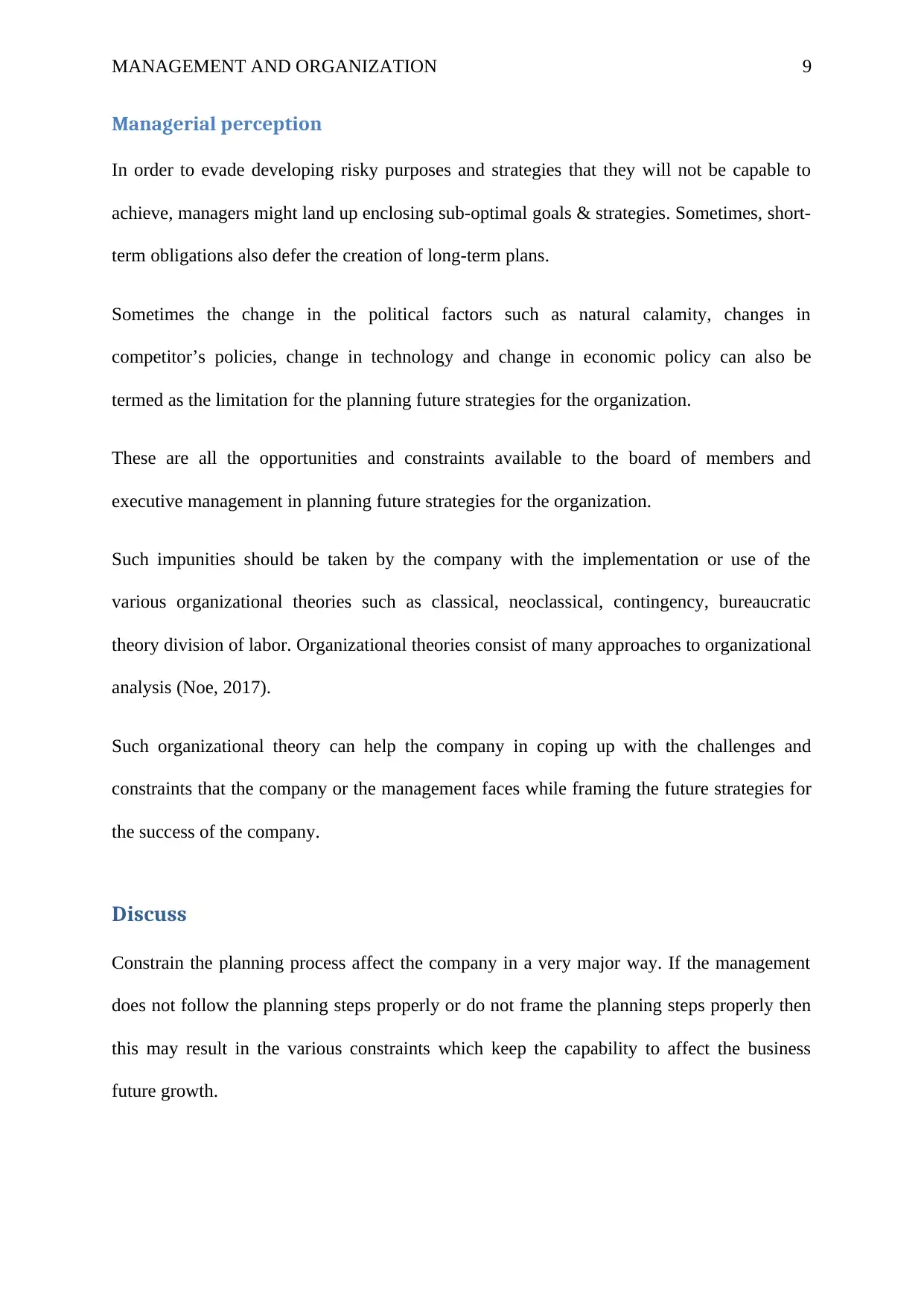
MANAGEMENT AND ORGANIZATION 9
Managerial perception
In order to evade developing risky purposes and strategies that they will not be capable to
achieve, managers might land up enclosing sub-optimal goals & strategies. Sometimes, short-
term obligations also defer the creation of long-term plans.
Sometimes the change in the political factors such as natural calamity, changes in
competitor’s policies, change in technology and change in economic policy can also be
termed as the limitation for the planning future strategies for the organization.
These are all the opportunities and constraints available to the board of members and
executive management in planning future strategies for the organization.
Such impunities should be taken by the company with the implementation or use of the
various organizational theories such as classical, neoclassical, contingency, bureaucratic
theory division of labor. Organizational theories consist of many approaches to organizational
analysis (Noe, 2017).
Such organizational theory can help the company in coping up with the challenges and
constraints that the company or the management faces while framing the future strategies for
the success of the company.
Discuss
Constrain the planning process affect the company in a very major way. If the management
does not follow the planning steps properly or do not frame the planning steps properly then
this may result in the various constraints which keep the capability to affect the business
future growth.
Managerial perception
In order to evade developing risky purposes and strategies that they will not be capable to
achieve, managers might land up enclosing sub-optimal goals & strategies. Sometimes, short-
term obligations also defer the creation of long-term plans.
Sometimes the change in the political factors such as natural calamity, changes in
competitor’s policies, change in technology and change in economic policy can also be
termed as the limitation for the planning future strategies for the organization.
These are all the opportunities and constraints available to the board of members and
executive management in planning future strategies for the organization.
Such impunities should be taken by the company with the implementation or use of the
various organizational theories such as classical, neoclassical, contingency, bureaucratic
theory division of labor. Organizational theories consist of many approaches to organizational
analysis (Noe, 2017).
Such organizational theory can help the company in coping up with the challenges and
constraints that the company or the management faces while framing the future strategies for
the success of the company.
Discuss
Constrain the planning process affect the company in a very major way. If the management
does not follow the planning steps properly or do not frame the planning steps properly then
this may result in the various constraints which keep the capability to affect the business
future growth.
Paraphrase This Document
Need a fresh take? Get an instant paraphrase of this document with our AI Paraphraser
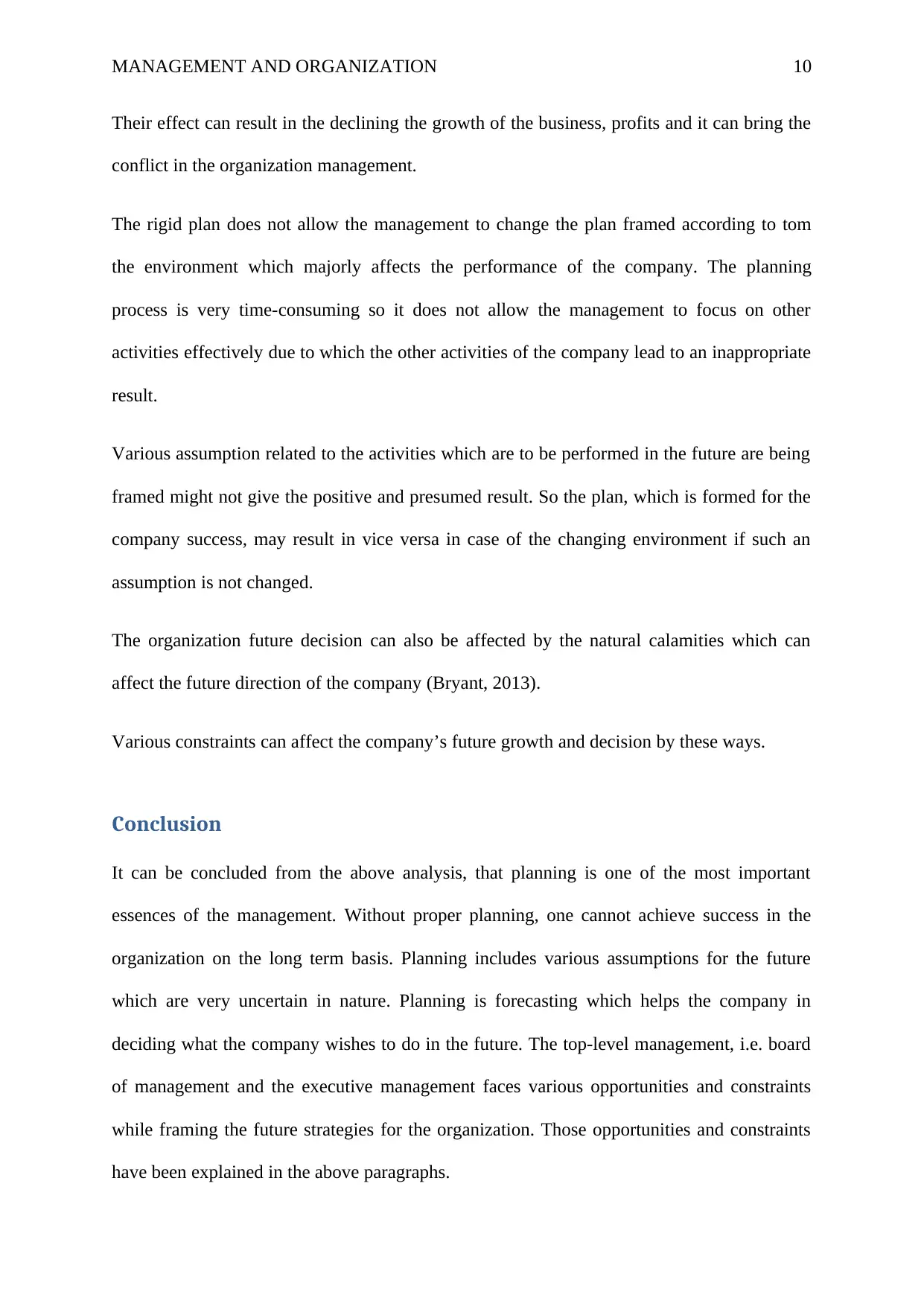
MANAGEMENT AND ORGANIZATION 10
Their effect can result in the declining the growth of the business, profits and it can bring the
conflict in the organization management.
The rigid plan does not allow the management to change the plan framed according to tom
the environment which majorly affects the performance of the company. The planning
process is very time-consuming so it does not allow the management to focus on other
activities effectively due to which the other activities of the company lead to an inappropriate
result.
Various assumption related to the activities which are to be performed in the future are being
framed might not give the positive and presumed result. So the plan, which is formed for the
company success, may result in vice versa in case of the changing environment if such an
assumption is not changed.
The organization future decision can also be affected by the natural calamities which can
affect the future direction of the company (Bryant, 2013).
Various constraints can affect the company’s future growth and decision by these ways.
Conclusion
It can be concluded from the above analysis, that planning is one of the most important
essences of the management. Without proper planning, one cannot achieve success in the
organization on the long term basis. Planning includes various assumptions for the future
which are very uncertain in nature. Planning is forecasting which helps the company in
deciding what the company wishes to do in the future. The top-level management, i.e. board
of management and the executive management faces various opportunities and constraints
while framing the future strategies for the organization. Those opportunities and constraints
have been explained in the above paragraphs.
Their effect can result in the declining the growth of the business, profits and it can bring the
conflict in the organization management.
The rigid plan does not allow the management to change the plan framed according to tom
the environment which majorly affects the performance of the company. The planning
process is very time-consuming so it does not allow the management to focus on other
activities effectively due to which the other activities of the company lead to an inappropriate
result.
Various assumption related to the activities which are to be performed in the future are being
framed might not give the positive and presumed result. So the plan, which is formed for the
company success, may result in vice versa in case of the changing environment if such an
assumption is not changed.
The organization future decision can also be affected by the natural calamities which can
affect the future direction of the company (Bryant, 2013).
Various constraints can affect the company’s future growth and decision by these ways.
Conclusion
It can be concluded from the above analysis, that planning is one of the most important
essences of the management. Without proper planning, one cannot achieve success in the
organization on the long term basis. Planning includes various assumptions for the future
which are very uncertain in nature. Planning is forecasting which helps the company in
deciding what the company wishes to do in the future. The top-level management, i.e. board
of management and the executive management faces various opportunities and constraints
while framing the future strategies for the organization. Those opportunities and constraints
have been explained in the above paragraphs.
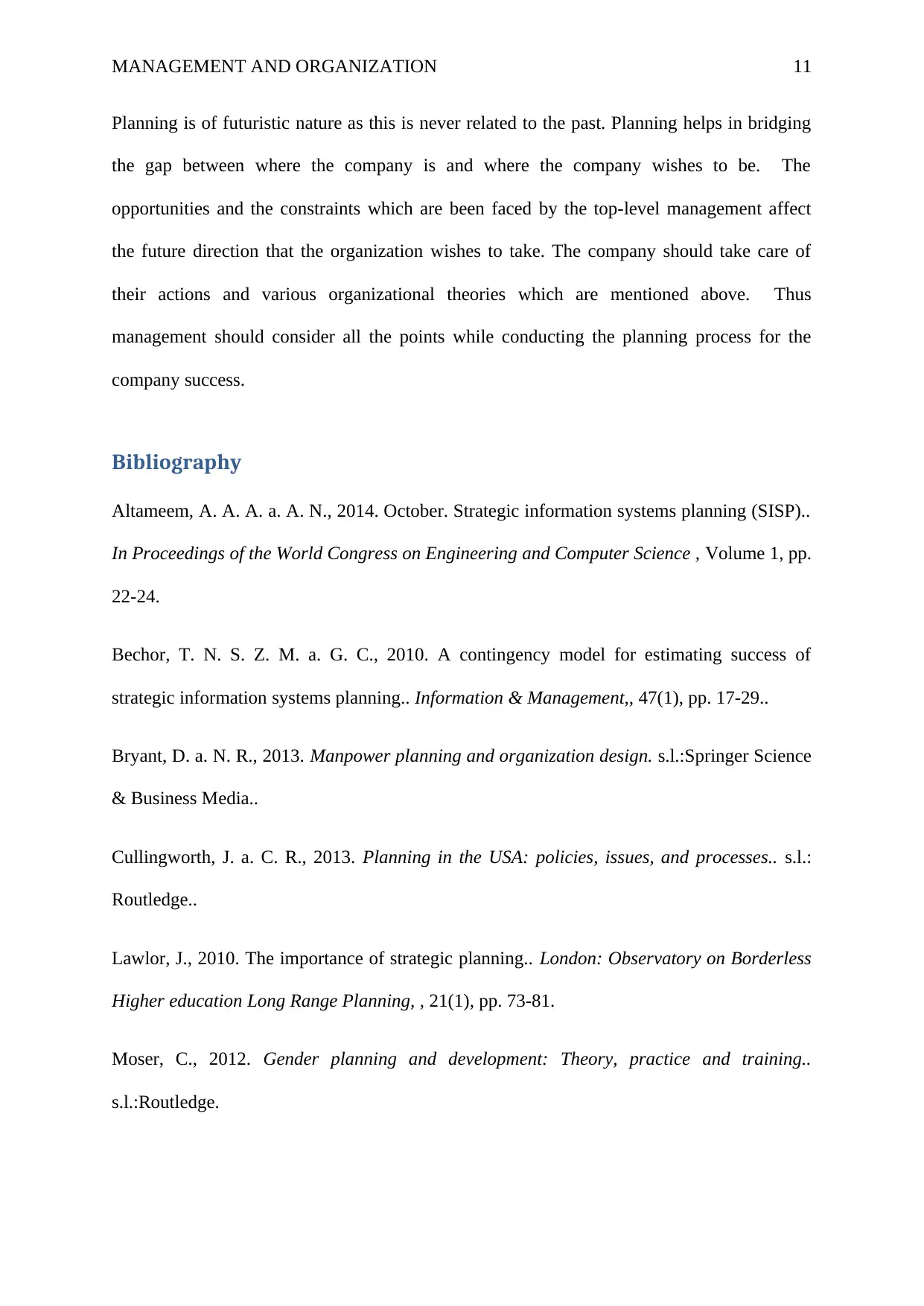
MANAGEMENT AND ORGANIZATION 11
Planning is of futuristic nature as this is never related to the past. Planning helps in bridging
the gap between where the company is and where the company wishes to be. The
opportunities and the constraints which are been faced by the top-level management affect
the future direction that the organization wishes to take. The company should take care of
their actions and various organizational theories which are mentioned above. Thus
management should consider all the points while conducting the planning process for the
company success.
Bibliography
Altameem, A. A. A. a. A. N., 2014. October. Strategic information systems planning (SISP)..
In Proceedings of the World Congress on Engineering and Computer Science , Volume 1, pp.
22-24.
Bechor, T. N. S. Z. M. a. G. C., 2010. A contingency model for estimating success of
strategic information systems planning.. Information & Management,, 47(1), pp. 17-29..
Bryant, D. a. N. R., 2013. Manpower planning and organization design. s.l.:Springer Science
& Business Media..
Cullingworth, J. a. C. R., 2013. Planning in the USA: policies, issues, and processes.. s.l.:
Routledge..
Lawlor, J., 2010. The importance of strategic planning.. London: Observatory on Borderless
Higher education Long Range Planning, , 21(1), pp. 73-81.
Moser, C., 2012. Gender planning and development: Theory, practice and training..
s.l.:Routledge.
Planning is of futuristic nature as this is never related to the past. Planning helps in bridging
the gap between where the company is and where the company wishes to be. The
opportunities and the constraints which are been faced by the top-level management affect
the future direction that the organization wishes to take. The company should take care of
their actions and various organizational theories which are mentioned above. Thus
management should consider all the points while conducting the planning process for the
company success.
Bibliography
Altameem, A. A. A. a. A. N., 2014. October. Strategic information systems planning (SISP)..
In Proceedings of the World Congress on Engineering and Computer Science , Volume 1, pp.
22-24.
Bechor, T. N. S. Z. M. a. G. C., 2010. A contingency model for estimating success of
strategic information systems planning.. Information & Management,, 47(1), pp. 17-29..
Bryant, D. a. N. R., 2013. Manpower planning and organization design. s.l.:Springer Science
& Business Media..
Cullingworth, J. a. C. R., 2013. Planning in the USA: policies, issues, and processes.. s.l.:
Routledge..
Lawlor, J., 2010. The importance of strategic planning.. London: Observatory on Borderless
Higher education Long Range Planning, , 21(1), pp. 73-81.
Moser, C., 2012. Gender planning and development: Theory, practice and training..
s.l.:Routledge.
⊘ This is a preview!⊘
Do you want full access?
Subscribe today to unlock all pages.

Trusted by 1+ million students worldwide
1 out of 13
Related Documents
Your All-in-One AI-Powered Toolkit for Academic Success.
+13062052269
info@desklib.com
Available 24*7 on WhatsApp / Email
![[object Object]](/_next/static/media/star-bottom.7253800d.svg)
Unlock your academic potential
Copyright © 2020–2025 A2Z Services. All Rights Reserved. Developed and managed by ZUCOL.





